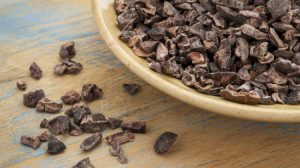14

Cacao Nibs
Often described as “nature’s chocolate chips,” cacao nibs are peeled and crumbled cacao beans, which are the dried, fatty seed of Theobroma cacao. The beans come from the fruit pod of cacao trees native to the Americas, mostly in the foothill basins of the Andes mountain range in South America.
Cacao trees grow in a limited geographical zone that ranges from 20 degrees south of the equator to 20 degrees north of it. There are three varieties – Forastero, which is the most widely cultivated, weighing in at around 95% of worldwide production.
Criollo cacao trees produce a lower yield, but are the highest in quality and considered a delicacy. And finally Trinitario, which is a hybrid of the other two. The African nation of Cote d’Ivoire leads the world in cacao production at 33% of total yield, or 1.65 million tons annually as per 2012 statistics.
Cacao seeds, or beans, are somewhat soft, ranging in color from a light lavender to purple. However, they become a dark brown through a natural fermentation process. Cacao was considered the food of the gods for its flavor and nutritional properties in Mesoamerica for thousands of years.
Cacao still retains that legendary status today, both in terms of nutrition, and for the tasty treats it helps create. Cacao nibs are a rich source of antioxidants such as procyanidins and flavonoids. And its stimulant activity comes from the compound theobromine.
Cacao Nibs Benefits
If there were any doubt to cacao’s health benefits, the incredible health of the Kuna people in Panama serves as a wonderful reminder why cacao is a top superfood.[71] These indigenous people living on small islands off the mainland are heavy consumers of cacao. They also have significantly lower rates of both cancer and heart disease, the top two causes of death in the modern world.
Per 100,000 people, the mainland of Panama experiences 83 deaths to cardiovascular disease and 68 to cancer. By comparison, the Kuna experience just 9 deaths to cardiovascular disease, and only 4 to cancer.
Cacao contains a number of beneficial nutrients, many of which become damaged when heated. So naturally, raw cacao will be more beneficial than processed cacao.
Cacao contains a wealth of antioxidants such as procyanidins, resveratrol, catechin, epicatechin, and various flavonoids. It’s high in vitamin C, tryptophan, and neurotransmitters like dopamine, serotonin, and phenethylamine – a potent mood enhancer. As well as the compound theobromine.
The theobromine content in cacao has been shown to kill a strain of bacteria that causes tooth decay, thus preventing cavities. Rather than causing them, like sweetened milk chocolate. Benefits of consuming cacao and cacao nibs include …
- Regulating blood sugar
- Improving cardiovascular health
- Preventing cancer
- Lowering blood pressure
- Reducing stress
- Improving cognitive function
- Boosting immunity
- Reducing inflammation
- Improving mood & increasing wellbeing
A recent study on cacao flavanol consumption in elderly subjects discovered that consuming cacao reduces age-related cognitive dysfunction.[72] High flavanol dark chocolate consumption has also been shown to enhance the widening of blood vessels which increases blood flow, and thus decreases blood pressure.[73]
A 2014 study on the antioxidant and anti-inflammatory effects of cacao consumption found that HDL (good) cholesterol increased, while glucose levels decreased, both of which contribute to improved cardiovascular health.[74]
The polyphenol antioxidants in cacao are responsible for many of its benefits, including (wait for it) contentment. In this 2013 study, 72 participants received a dark chocolate drink mix for 30 days in varying doses.[75] The highest dose group reported, “significantly increased self-rated calmness and contentedness relative to placebo.”
But perhaps the greatest endorsement for cacao consumption comes from Jeanne Louise Calment, who lived to the age of 122 (longest “confirmed” human lifespan).[76] She smoked cigarettes till the age of 117, which isn’t advisable. But she also ate 2 pounds of dark chocolate every week. By contrast, those large bars you try not to devour in one sitting are only 3.5 ounces, or 1/9 her weekly consumption.
Cacao Nibs Uses
What can’t you do with cacao nibs, cacao powder, and cacao butter? You’re truly only limited by your own imagination. Though it helps to have internet. And this Pinterest page of cacao recipes will make you want to dive into a large vat of melted dark chocolate head first. Chocolate pasta, anyone?
Cacao nibs can be used as an ingredient in a superfood trail mix (like my simple blend of cacao nibs, gogi berries, bilberries, and pumpkin seeds), blended into smoothies, used in baking (nature’s chocolate chips, remember?) or sprinkled on just about anything your heart desires.
Check out this video recipe for a healthy chocolate fudge courtesy of nutritional cook Susan Jane White. Let me warn you of two things, though. First, click on the link above for the recipe, and make sure you have all the ingredients to make this fudge. Cause trust me, you’ll want (or need) to make it right away. And second, a large bib will be required. Cause you’re going to drool all over yourself.
If you want to make the recipe even healthier, try substituting yacon syrup for the date syrup, or perhaps a combination of the two. Yacon is a wonderful superfood in its own right, and a supreme natural sweetener.
You may be able to get Navitas Naturals cacao nibs at your local supermarket. If not, you can order them through iHerb (which is usually cheaper), and get $5 off in the process simply by following that link. If choosing another brand, make sure you’re purchasing raw and organic.
